Timeline of healthcare in Japan
Jump to navigation
Jump to search
The content on this page is forked from the English Wikipedia page entitled "Timeline of healthcare in Japan". The original page still exists at Timeline of healthcare in Japan. The original content was released under the Creative Commons Attribution/Share-Alike License (CC-BY-SA), so this page inherits this license.
This is a timeline of healthcare in Japan. Major events such as crises, policies and organizations are included, especially those focusing on modern healthcare.
Big picture
| Year/period | Key developments |
|---|---|
| 6th-7th Centuries | Kampō medicine, which is the study of Chinese medicine, is introduced in Japan through Korea. Based on this study, the Japanese create their own unique system of diagnosis and therapy.[1] |
| 1200-1603 | Medicine in Japan becomes more practical. Most of the physicians are Buddhist monks who continue to use the formulas, theories and practices that had been introduced from Tang China. Japanese physicians begin to achieve a more independent view on Chinese medicine.[2] |
| 1603-1868 | Edo period. Rangaku, literally "Dutch learning" is developed in Japan through its contacts with the Dutch colonists as they are the only European foreigners tolerated in Japan. Books and medical sciences are obtained from the Dutch, and then analyzed and translated into Japanese. Great debates occur between the proponents of traditional Chinese medicine and those of the new Western learning.[3] |
| 1853-1922 | Meiji Restoration. Japan opens to Western influence. Several Western hospitals start to be founded. Traditional medicine enters a period of rapid decline.[2] |
| 1922-onward | With a pertaining law, modern health care system develops initially emulating the German system. Health insurance is established as mandatory.[4] |
| 1950-1990 | Japanese economic miracle era. Life expectancy rises rapidly as mortality rates due to communicable diseases plummet, followed by a large reduction in stroke mortality rates.[5] |
| 1990–present | Japan achieves the highest life expectancy of any country in the world. Also, child mortality falls among the lowest levels at a global scale. Actual issues of its healthcare system are the growing senior population that has impact on government spending, and high rates of suicide among the Japanese.[6][7] |
Full timeline
| Year/period | Type of Event | Event | Location |
|---|---|---|---|
| 912–995 | Development | Ishinpō, the oldest surviving Japanese medical text is written by Tamba Yasuyori.[9] | |
| 1804 | Development | The first operation performed under general anesthesia by a Japanese physician, Hanaoka Seishu, using a datura.[10] | |
| 1820s | Development | Japanese ranpô medical practitioners translate Dutch medical texts, also integrating their readings with clinical diagnoses.[11] | |
| 1871 | Discovery/infection | The first case of Japanese encephalitis viral disease (JE) is documented in Japan.[12] | |
| 1872 | Organization (public medical school) | Kyoto Prefectural University of Medicine is established.[13][14] | Kyoto |
| 1874 | Organization (hospital) | Juzen Hospital is founded into what will later become Yokohama City University Hospital.[15][16] | Yokohama |
| 1889 | Organization (hospital) | Koyama Fukusei Hospital is founded.[17] | Gotemba, Shizuoka |
| 1891 | Organization (hospital) | St. Luke's International Hospital is founded as a medical mission facility by the Episcopal Church in the United States. The hospital is now one of central Tokyo's largest and most comprehensive medical care facilities.[18] | Tokyo |
| 1891 | Organization (private medical school) | Kitasato Shibasaburō (disciple of Robert Koch), founds the first Institute of Infectious Diseases, thus introducing the study of bacteriology in Japan.[19] | Tokyo |
| 1901 | Organization (private medical school) | Iwate Medical University is established.[20][21] | Morioka, Iwate |
| 1905 | Development | National health insurance emerges in Japan as the result of a gradual process when the Kamegafuchi Textile Company starts providing limited benefits for its employees. In the following decades, more and more corporations begin offering benefits through mutual aid societies.[4] | |
| 1909 | Organization (hospital) | Oku-Komyo-En Sanatorium is founded for treating leprosy.[22] | Setouchi, Okayama |
| 1909 | Organization (hospital) | Kikuchi Keifuen Sanatorium is established as a sanatorium for leprosy patients or ex-leprosy patients.[23] | Koshi, Kumamoto |
| 1913 | Organization (hospital) | Kizawa Memorial Hospital is founded.[24][25] | Gifu |
| 1918 | Organization (hospital) | Tokyo Medical University (TMU) is founded with the then status of Tokyo Isen. TMU is one of the old medical schools of Japan’s Taishō period. The school will not receive university status until 1946.[26][27] | Tokyo |
| 1922 | Policy | First health insurance law enacted. Inspired by the German system established by Chancellor Bismarck in 1883.[4] | |
| 1927 | Policy | The first Employee Health Insurance plan is created following the implementation of the 1922 law. Aimed at industrial employees and miners, but excluding the self-employed and employees in companies with fewer than five.[4][28] | |
| 1927 | Organization (private medical school) | Osaka Higher School of Medicine is established.[29][30] | Takatsuki, Osaka |
| 1928 | Organization (public medical school) | Tokyo Medical and Dental University is established.[31] | Bunkyō, Tokyo |
| 1928 | Organization (private medical school) | Showa Medical School is established.[32][33] | Tokyo |
| 1930 | Organization (hospital) | Nagashima Aiseien Sanatorium is founded for the treatment of leprosy.[34][35] | Setouchi, Okayama |
| 1931 | Organization (hospital) | Miyako Nanseien Sanatorium is founded.[36] | Miyakojima, Okinawa |
| 1932 | Organization (hospital) | Kuryu Rakusen-en Sanatorium is founded.[37] | Kusatsu, Gunma |
| 1933 | Organization (hospital) | Shima Hospital is founded (destroyed during the atomic bomb explosion).[38] | Hiroshima |
| 1938 | Policy | Health insurance is extended to farmers, fishermen, foresters and other groups not covered by the 1922 law.[4] | |
| 1938 | Organization (hospital) | Okinawa Airakuen Sanatorium is founded for leprosy patients.[39] | Nago, Okinawa |
| 1943 | Organization (hospital) | Amami Wakoen Sanatorium is founded for treating for leprosy or ex-leprosy patients.[40] | Amami, Kagoshima |
| 1944 | Organization (public medical school) | Fukushima Woman's Medical School is established.[41][42] | Fukushima, Fukushima |
| 1945 | Organization (hospital) | Suruga Sanatorium is founded for treating leprosy.[43][44] | Gotenba, Shizuoka |
| 1945 | Organization (public medical school) | Nara Medical School is founded.[45] | Kashihara, Nara |
| 1947 | Organization (private medical school) | Osaka Women’s Medical College is established. In 1954, it is renamed Kansai Medical University.[46][47] | Moriguchi, Osaka |
| 1948 | Organization (public medical school) | Wakayama Medical University is established.[48][49] | Wakayama, Wakayama |
| 1949 | Program launch | Several volunteer organizations are formed to combat parasitic worms. Biannual school-based mass screening and treatment are implemented.[50] | |
| 1950 | Organization (public medical school) | Sapporo Medical University is founded.[51][52] | Sapporo |
| 1952 | Organization (hospital) | NTT Medical Center Tokyo is founded.[53] | Shinagawa, Tokyo |
| 1955 | Program launch | The Japan Association of Parasite Control (JAPC) is formed, aimed especially at targeting Ascaris lumbricoides infection.[50] | |
| 1957 | Organization (research institute) | National Institute of Radiological Sciences founded.[54][55] | Inage-ku (Chiba) |
| 1958 | Policy | the 1938 law is revised to include the remaining 30 percent of the population not previously covered.[4] | |
| 1961 | Policy/achievement | Japan achieves universal health insurance coverage and almost everyone becomes insured.[4][56] | |
| 1964 | Organization (private medical school) | Fujita Health University is founded.Template:Fix/category[citation needed] | Toyoake, Aichi |
| 1967 | Policy | The Ministry of Health, Labour and Welfare approves four Kampō medicines for reimbursement under the National Health Insurance (NHI) program.[57] | |
| 1970 | Organization (private medical school) | Kawasaki Medical School is established.[58][59] | Kurashiki, Japan |
| 1970 | Organization (hospital) | Kanagawa Children's Medical Center founded.[60] | Yokohama |
| 1971 | Organization (private medical school) | St. Marianna University School of Medicine is founded.[61] | Miyamae-ku, Kawasaki |
| 1971 | Organization (private medical school) | Aichi Medical University is founded.[62] | Nagakute, Aichi |
| 1971 | Organization (hospital) | Fujisawa City Hospital founded.[63] | Fujisawa |
| 1972 | Organization (private medical school) | Saitama Medical University is established.[64][65] | Moroyama, Saitama |
| 1972 | Organization (private medical school) | Jichi Medical University is established.[66][67] | Shimotsuke, Tochigi |
| 1972 | Organization (private medical school) | Hyogo College of Medicine is established.[68][69] | Nishinomiya, Hyōgo |
| 1972 | Organization (private medical school) | Kanazawa Medical University is established.[70][71] | Uchinada, Ishikawa |
| 1973 | Organization (public medical school) | Asahikawa Medical University is established.[72] | Asahikawa, Hokkaido |
| 1973 | Organization (public medical school) | National Defense Medical College is founded.[73][74] | Tokorozawa, Saitama |
| 1974 | Organization (public medical school) | Shiga University of Medical Science is founded.[75][76] | Ōtsu, Shiga |
| 1974 | Organization (public medical school) | Hamamatsu University School of Medicine is founded.[77] | Hamamatsu |
| 1973 | Policy | Catastrophic Coverage Act is enacted. Once a patient's monthly copayment reaches a cap, no further copayment is required.[78] | |
| 1976 | Policy | 82 kampo medicines are approved by the Ministry of Health, Labour and Welfare. This number increases to 148 Kampo formulation extracts, 241 crude drugs, and 5 crude drug preparations.[57] | |
| 1978 | Organization (private medical school) | University of Occupational and Environmental Health Japan is founded.[79][80] | Kitakyushu City |
| 1983 | Policy | Health and Medical Service Law for the Aged enacted. All elderly persons are covered by government-sponsored insurance.[4][81] | |
| 1986 | Organization (research center-hospital) | Kanagawa Cancer Center is founded.[82] | Kanagawa |
| 2000 | Study | Nationwide study reports that 72% of registered physicians prescribe Kampō medicines.[83] | |
| 2005 | Organization (hospital) | National Hospital Organization Nagara Medical Center founded.[84] | Gifu |
| 2009 | Report | John Creighton Campbell, professor at the University of Michigan and Tokyo University, tells the New York Times that Japanese people are "the healthiest" group on the planet.[85] | |
| 2009 | Achievement | People in Japan reaches the longest life expectancy at birth of any country in the world at 83 years (male 79.6 years, female 86.4 years).[86] | |
| 2011 | Policy | The Government of Japan begins issuing six-month medical visas to allow visitors that much time to receive medical treatment in Japan. The government also plans to set up a special office that will promote medical tourism.[10] | |
| 2011 | Study | A study of 13 industrialized countries (Australia, United Kingdom, Canada, Denmark, France, Germany, Japan, the Netherlands, New Zealand, Norway, Sweden, Switzerland and United States) released shows Japan spending the least on health care.[10] | |
| 2011 | Organization (hospital) | Nagoya City West Medical Center is founded.[87] | Kita-ku, Nagoya |
| 2011 | Crisis | Medical records at many hospitals along the Tohoku coast are lost in the tsunami.[10] | |
| 2014 | Report | Statistics show for the first time that suicide is the most common cause of death among those aged 10 to 19.[88][89] | |
| 2014 | Achievement | Japan reaches the lowest rate of heart disease in the OECD, and the lowest level of dementia in the developed world.[90] |
Numerical and visual data
Google Scholar
The following table summarizes per-year mentions on Google Scholar as of June 5, 2021.
| Year | health in Japan | healthcare in Japan | medicine in japan | longevity in Japan |
|---|---|---|---|---|
| 1980 | 13,300 | 53 | 14,300 | 632 |
| 1985 | 18,300 | 94 | 22,800 | 1,020 |
| 1990 | 39,500 | 417 | 50,600 | 1,580 |
| 1995 | 75,600 | 1,270 | 84,900 | 3,640 |
| 2000 | 212,000 | 4,770 | 183,000 | 5,190 |
| 2002 | 267,000 | 6,880 | 201,000 | 6,050 |
| 2004 | 333,000 | 9,520 | 251,000 | 7,820 |
| 2006 | 424,000 | 14,700 | 274,000 | 9,040 |
| 2008 | 454,000 | 31,900 | 347,000 | 10,200 |
| 2010 | 571,000 | 53,500 | 373,000 | 10,000 |
| 2012 | 624,000 | 82,000 | 478,000 | 16,000 |
| 2014 | 509,000 | 90,200 | 412,000 | 17,600 |
| 2016 | 440,000 | 88,100 | 303,000 | 18,800 |
| 2017 | 370,000 | 83,700 | 247,000 | 20,600 |
| 2018 | 286,000 | 76,200 | 197,000 | 21,700 |
| 2019 | 195,000 | 62,900 | 142,000 | 22,600 |
| 2020 | 104,000 | 49,600 | 88,900 | 20,400 |
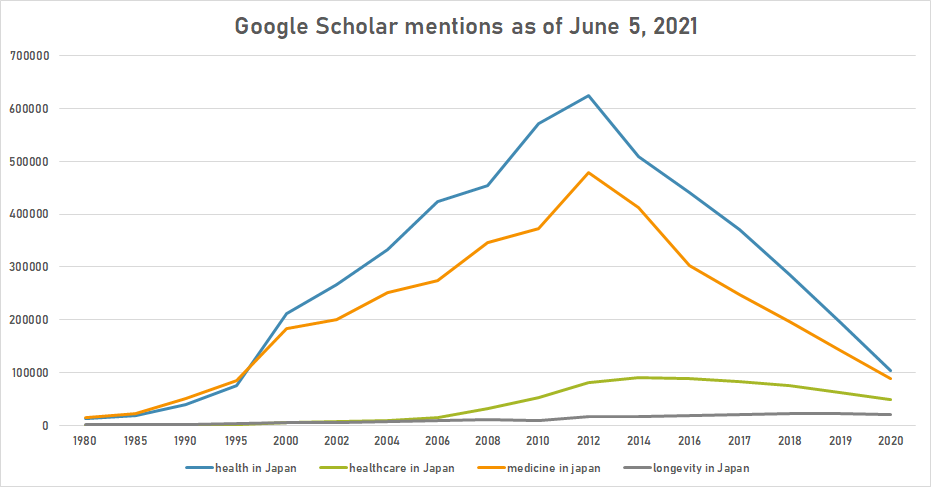
Google Trends
The image below shows Google Trends data for Healthcare in Japan (Search term) from January 2004 to February 2021, when the screenshot was taken. Interest is also ranked by country and displayed on world map.[91]
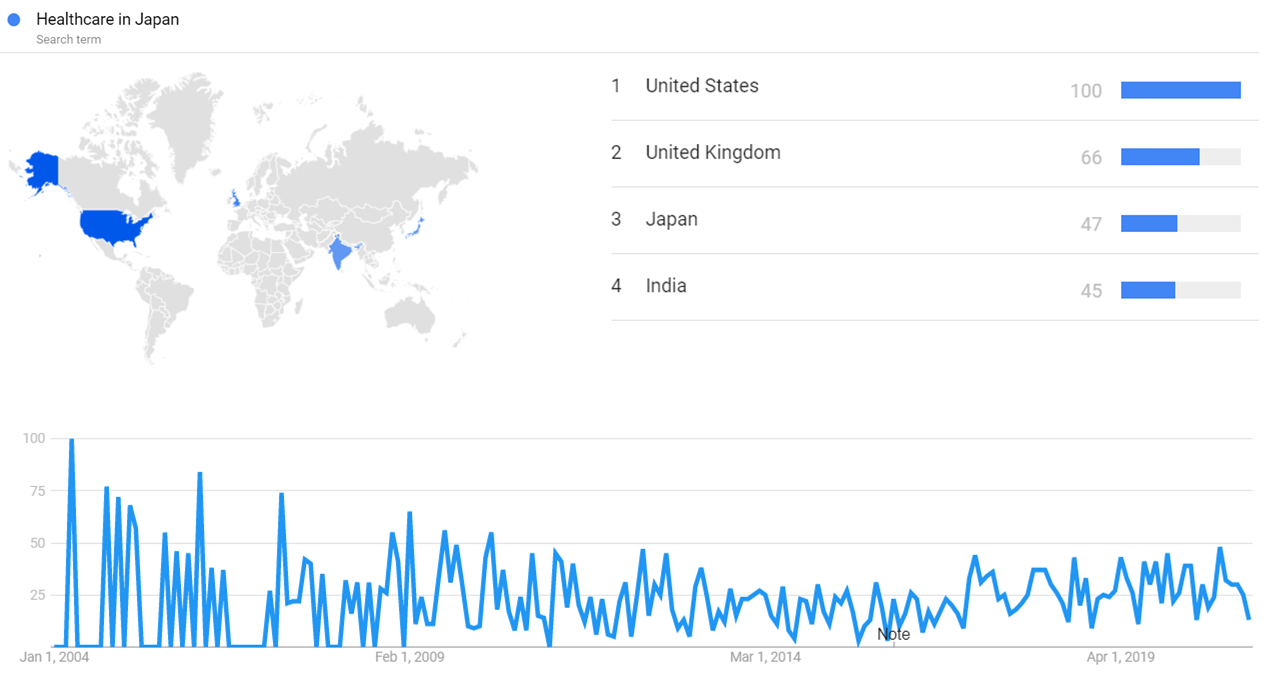
Google Ngram Viewer
The chart shows Google Ngram Viewer data for Healthcare in Japan from 1950 to 2019.[92]
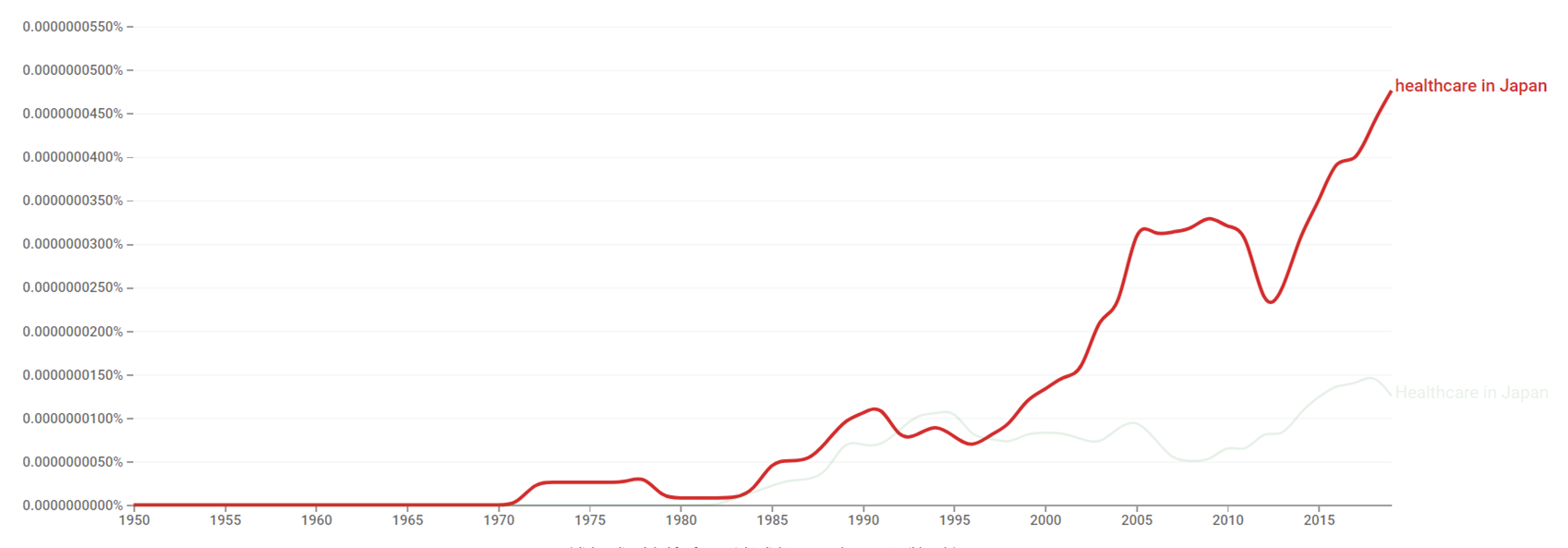
Wikipedia Views
The chart below shows pageviews of the English Wikipedia article Healthcare in Japan, on desktop, mobile-web, desktop-spider, mobile-web-spider and mobile app, from July 2015 to January 2021.[93]
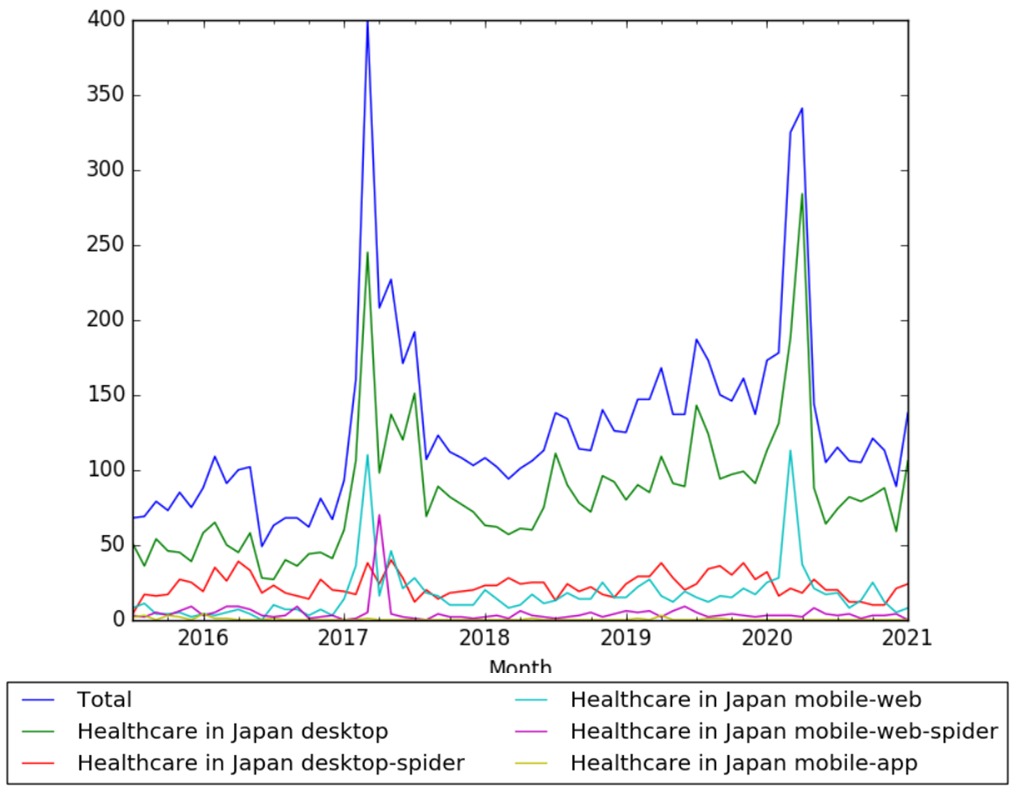
What the timeline is still missing
See also
- Health care system in Japan
- Health in Japan
- Timeline of healthcare in China
- Timeline of healthcare in India
- Timeline of global health
References
- ↑ Dharmananda, Subhuti. "Kampo Medicine: The Practice of Chinese Herbal Medicine in Japan". Institute for Traditional Medicine. Retrieved December 12, 2010.
- ↑ 2.0 2.1 Y. Motoo; T. Seki; K. Tsutani (February 2011). "Traditional Japanese medicine, Kampo: its history and current status". 17 (2). Chinese Journal of Integrative Medicine: 85–87. doi:10.1007/s11655-011-0653-y. PMID 21390572.
{{cite journal}}: Cite journal requires|journal=(help) - ↑ W Michel, Medicine and Allied Sciences in the Cultural Exchange between Japan and Europe in the Seventeenth Century. In: Hans Dieter Ölschleger (Hrsg.): Theories and Methods in Japanese Studies. Current State & Future Developments. Papers in Honor of Josef Kreiner. Vandenhoeck & Ruprecht Unipress, Göttingen 2007, ISBN 978-3-89971-355-8, S. 285–302 pdf.
- ↑ 4.0 4.1 4.2 4.3 4.4 4.5 4.6 4.7 "History of healthcare in Japan".
- ↑ Ikeda, Nayu (17 September 2011). "What has made the population of Japan healthy?". The Lancet. 378 (9796): 1094–105. doi:10.1016/S0140-6736(11)61055-6. PMID 21885105.
- ↑ Faiola, Anthony (28 July 2006). "The Face of Poverty Ages In Rapidly Graying Japan". The Washington Post. Retrieved 21 February 2016.
- ↑ Strom, Stephanie (15 July 1999). "In Japan, Mired in Recession, Suicides Soar". The New York Times. Retrieved 2008-09-20.
- ↑ "Life Expectancy". Retrieved 2 January 2017.
- ↑ "Prescriptions from the Heart of Medicine (Ishinpō)". National Institutes for Cultural Heritage. Retrieved August 25, 2014.
- ↑ 10.0 10.1 10.2 10.3 "HEALTH CARE IN JAPAN: HISTORY, DOCTORS AND HEALTH INSURANCE".
- ↑ Ann Jannetta, The Vaccinators: Smallpox, Medical Knowledge and the "Opening" of Japan (2007)
- ↑ "Japanese encephalitis".
- ↑ "History of the University". kpu-m.ac.jp. Retrieved 30 December 2016.
- ↑ "Kyoto Prefectural University of Medicine (KPUM)". natureindex.com. Retrieved 30 December 2016.
- ↑ "Growing with the International City of Yokohama". yokohama-cu.ac.jp. Retrieved 31 December 2016.
- ↑ "Yokohama City University" (PDF). jice.org. Retrieved 31 December 2016.
- ↑ "Camp Zama community members visit hospital in Japan's Gotemba City". army.mil. Retrieved 30 December 2016.
- ↑ Hobart, Margaret (1912). Institutions Connected with the Japan Mission of the American Church. New York: The Domestic and Foreign Missionary Society. Retrieved 30 December 2016.
- ↑ "Shibasaburo Kitasato y Alexandre Yersin". timerime.com. Retrieved 1 January 2017.
- ↑ "Iwate Medical University". Retrieved 1 January 2016.
- ↑ "Iwate Medical University". researchgate.net. Retrieved 30 December 2016.
- ↑ "National Sanatorium Oku-Komyoen". nhds.go.jp. Retrieved 30 December 2016.
- ↑ "Kikuchi Keifuen Sanatorium". nhds.go.jps. Retrieved 31 December 2016.
- ↑ "kizawa memorial".
- ↑ "Kizawa Memorial Hospital". strol.com. Retrieved 30 December 2016.
- ↑ "Tokyo Medical University". Retrieved 8 August 2016.
- ↑ "Tokyo Medical University". omicsonline.org. Retrieved 30 December 2016.
- ↑ Kōdansha 1993, p. 338.
- ↑ "Osaka Medical College". osaka-med.ac.jp. Retrieved 30 December 2016.
- ↑ Kuroki, Hiroshi. "Efficacy of the Osaka Medical College (OMC) brace in the treatment of adolescent idiopathic scoliosis following Scoliosis Research Society brace studies criteria". doi:10.1186/s13013-015-0036-9. Retrieved 30 December 2016.
{{cite journal}}: Cite journal requires|journal=(help)CS1 maint: unflagged free DOI (link) - ↑ "Tokyo Medical and Dental University (TMDU)". timeshighereducation.com. Retrieved 30 December 2016.
- ↑ "THE HISTORY OF SHOWA UNIVERSITY". showa-u.ac.jp. Retrieved 30 December 2016.
- ↑ "Showa University". timeshighereducation.com. Retrieved 30 December 2016.
- ↑ "Nagashima Aiseien Sanatorium" (PDF). Retrieved 8 August 2016.
- ↑ McVeigh, Brian J. The History of Japanese Psychology: Global Perspectives, 1875-1950. Retrieved 30 December 2016.
- ↑ "Miyako Nanseien Sanatorium". latitude.to. Retrieved 30 December 2016.
- ↑ Hospitals Established In 1932: Alyn Hospital, Royal United Hospital, Paimio Sanatorium, Kuryu Rakusen-en Sanatorium, Beckomberga Hospital (LLC Books ed.). General Books LLC, 2010. ISBN 1157475663. Retrieved 30 December 2016.
- ↑ "Hypocenter / Shima Hospital". hiroshima-navi.or.jp. Retrieved 30 December 2016.
- ↑ "Okinawa Airakuen Sanatorium". Retrieved 2 January 2017.
- ↑ "Amami Wakoen Sanatorium". tophealthclinics.com. Retrieved 30 December 2016.
- ↑ "Chronology". fmu.ac.jp. Retrieved 30 December 2016.
- ↑ "Japan pioneers new electronic stethoscope". intellectualcapitals.com. Retrieved 30 December 2016.
- ↑ "Suruga Sanatorium" (PDF). Retrieved 8 August 2016.
- ↑ "List of Hospital(s) places around around Fuji, Japan". placebeam.com. Retrieved 30 December 2016.
- ↑ "History". naramed-u.ac.jp. Retrieved 30 December 2016.
- ↑ "History". kmu.ac.jp. Retrieved 30 December 2016.
- ↑ "Kansai Medical University". 4icu.org. 4icu.org. Retrieved 30 December 2016.
- ↑ "Wakayama Medical University". Retrieved 8 August 2016.
- ↑ "Wakayama Medical University Wakayama Medical University". University Web Rankings & Reviews. Retrieved 30 December 2016.
- ↑ 50.0 50.1 "STH Elimination Strategy Support - Objective 1: Past STH Elimination Programs" (PDF). University of Washington Global Health START Program. February 17, 2015.
- ↑ "Sapporo Medical University". Retrieved 8 August 2016.
- ↑ "Sapporo Medical University Sapporo Medical University". University Web Rankings & Reviews. Retrieved 30 December 2016.
- ↑ "NTT Medical Center Tokyo and UBIC Conduct Joint Research on AI-Based System to Mitigate Patients' Risk of Falling". ubicna.com. Retrieved 2 January 2017.
- ↑ "Contributions for NIRS". qst.go.jp. Retrieved 2 January 2017.
- ↑ Nakashima, Masahiro. Radiation Health Risk Sciences: Proceedings of the First International Symposium of the Nagasaki University Global COE Program "Global Strategic Center for Radiation Health Risk Control".
{{cite book}}:|access-date=requires|url=(help) - ↑ Ikegami, Naoki (17 September 2011). "Japanese universal health coverage: evolution, achievements, and challenges". The Lancet. 378 (9796): 1108. doi:10.1016/S0140-6736(11)60828-3. PMID 21885107.
- ↑ 57.0 57.1 Kotoe Katayama; et al. (2013). "Prescription of Kampo Drugs in the Japanese Health Care Insurance Program" (PDF). Evidence-Based Complementary and Alternative Medicine. 2013. Hindawi Publishing Corporation: 576973. doi:10.1155/2013/576973. Retrieved August 25, 2014.
{{cite journal}}: Explicit use of et al. in:|author=(help)CS1 maint: unflagged free DOI (link) - ↑ "Kawasaki Medical School". kawasaki-m.ac.jp. Retrieved 2 January 2017.
- ↑ "Kawasaki Medical School". japantimes.co.jp. Retrieved 2 January 2017.
- ↑ "Kanagawa Children's Medical Center". grid.ac. Retrieved 2 January 2017.
- ↑ "St. Marianna University School of Medicine St. Marianna University School of Medicine". 4icu.org. Retrieved 2 January 2017.
- ↑ "Aichi Medical University". 4icu.org. Retrieved 2 January 2017.
- ↑ "Fujisawa City Hospital". Fujisawa City Hospital. Retrieved 8 August 2016.
- ↑ "history". saitama-med.ac.jp. Retrieved 2 January 2017.
- ↑ "More about Saitama Medical University". timeshighereducation.com. Retrieved 30 December 2016.
- ↑ "History". jichi.ac.jp. Retrieved 30 December 2016.
- ↑ "Jichi Medical University". University Web Rankings & Reviews. Retrieved 30 December 2016.
- ↑ "HISTORY". hyo-med.ac.jp. Retrieved 30 December 2016.
- ↑ "Hyogo College of Medicine". University Web Rankings & Reviews. Retrieved 30 December 2016.
- ↑ "Kanazawa Medical University". kanazawa-med.ac.jp. Retrieved 30 December 2016.
- ↑ "Kanazawa Medical University". University Web Rankings & Reviews. Retrieved 30 December 2016.
- ↑ "Asahikawa Medical University". omicsonline.org. Retrieved 30 December 2016.
- ↑ "National Defense Medical College". Retrieved 30 December 2016.
- ↑ "National Defense Medical College". Retrieved 2 January 2017.
- ↑ "History". shiga-med.ac.jp. Retrieved 30 December 2016.
- ↑ "Shiga University of Medical Science". University Web Rankings & Reviews. Retrieved 30 December 2016.
- ↑ "History". hama-med.ac.jp. Retrieved 30 December 2016.
- ↑ Ito, Masanori (December 2004). "Health insurance systems in Japan: a neurosurgeon's view". Neurologia medico-chirurgica. 44 (12): 624. doi:10.2176/nmc.44.617. PMID 15684593.
- ↑ "Objectives & History". uoeh-u.ac.jp. Retrieved 30 December 2016.
- ↑ "University of Occupational and Environmental Health, Japan". University Web Rankings & Reviews. Retrieved 30 December 2016.
- ↑ 講談社インターナショナル 2003, p. 183
- ↑ "Kanagawa Cancer Center". uicc.org. Retrieved 30 December 2016.
- ↑ "Legal Status of Traditional Medicine and Complementary/Alternative Medicine:A Worldwide Review" (PDF). 2001. pp. 155–159. Retrieved August 25, 2014.
- ↑ "National Hospital Organization Nagara Medical Center". tophealthclinics.com. Retrieved 30 December 2016.
- ↑ Arnquist, Sarah (25 August 2009). "Health Care Abroad: Japan". The New York Times.
- ↑ OECD. "OECD Health Data". OECD. Retrieved 2 February 2012.
- ↑ "Nagoya City West Medical Center". ad-hzm.co.jp. Retrieved 30 December 2016.
- ↑ mhlw.go.jp 第7表死因順位 Accessed 9/1/2015
- ↑ Mariko Oi Tackling the deadliest day for Japanese teenagers BBC News 9/1/2015
- ↑ Britnell, Mark (2015). In Search of the Perfect Health System. London: Palgrave. p. 18. ISBN 978-1-137-49661-4.
- ↑ "Healthcare in Japan". Google Trends. Retrieved 25 February 2021.
- ↑ "Healthcare in Japan". books.google.com. Retrieved 25 February 2021.
- ↑ "Healthcare in Japan". wikipediaviews.org. Retrieved 24 February 2021.